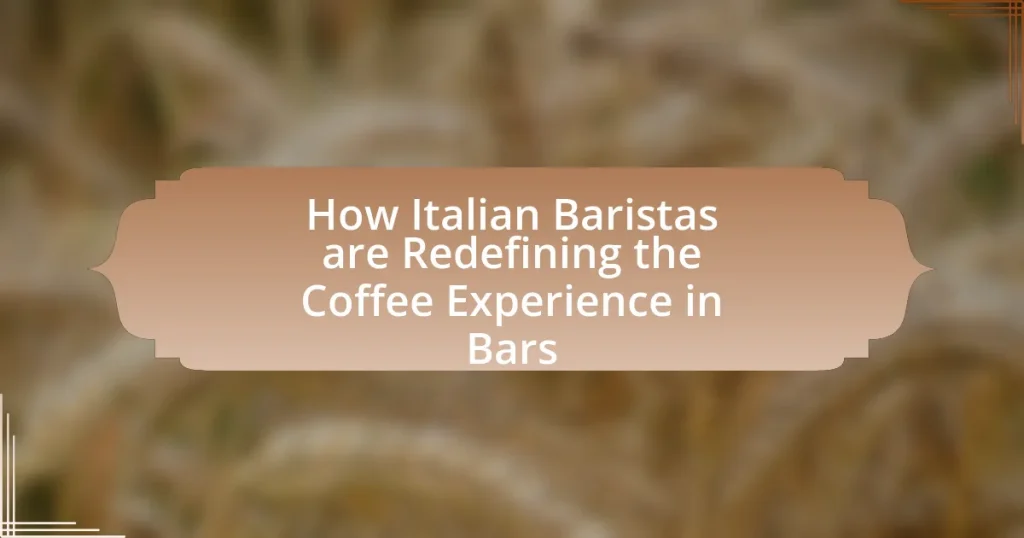Italian baristas are transforming the coffee experience in bars by prioritizing quality, craftsmanship, and customer interaction. They utilize traditional brewing methods, such as espresso preparation, while also incorporating innovative techniques like latte art and specialty drinks. The article explores the unique practices of Italian baristas, including their meticulous espresso-making process, the significance of milk frothing, and the cultural ambiance of Italian bars that fosters community engagement. Additionally, it discusses how modern technology and evolving consumer preferences are shaping the role of baristas, the challenges they face, and the strategies they employ to enhance the overall coffee experience.

How are Italian Baristas Redefining the Coffee Experience in Bars?
Italian baristas are redefining the coffee experience in bars by emphasizing quality, craftsmanship, and customer engagement. They focus on sourcing high-quality beans, often from specific regions, and employ traditional brewing methods, such as espresso preparation, to enhance flavor profiles. This dedication to quality is supported by Italy’s rich coffee culture, which values the art of coffee making as a social ritual. Additionally, baristas are increasingly incorporating innovative techniques and presentations, such as latte art and specialty drinks, to create a more personalized experience for customers. This shift not only elevates the coffee itself but also transforms the bar environment into a space for community interaction and appreciation of coffee as an artisanal product.
What unique techniques do Italian Baristas employ in coffee preparation?
Italian baristas employ unique techniques such as the use of traditional espresso machines, precise temperature control, and the art of milk frothing to enhance coffee preparation. These baristas often utilize high-quality, locally sourced beans and focus on the extraction process, ensuring optimal flavor through specific grind sizes and tamping pressure. Additionally, they emphasize the importance of serving coffee in specific glassware to enhance the sensory experience, which is rooted in Italy’s rich coffee culture. This meticulous approach not only preserves the integrity of the coffee but also elevates the overall drinking experience, reflecting Italy’s dedication to coffee craftsmanship.
How does the espresso-making process differ in Italian bars?
The espresso-making process in Italian bars emphasizes speed, precision, and tradition, distinguishing it from other coffee-making methods. Italian baristas typically use high-quality, freshly roasted beans and a specific grind size to ensure optimal extraction. The process often involves a manual lever or a traditional espresso machine, which allows for greater control over pressure and temperature, resulting in a rich, full-bodied shot of espresso. Additionally, the serving style in Italian bars is unique; espresso is usually served in small cups without milk, encouraging a quick consumption experience that aligns with the Italian coffee culture. This method is rooted in historical practices, as Italy has a long-standing tradition of espresso dating back to the early 20th century, making it a cornerstone of Italian social life.
What role does milk frothing play in the Italian coffee experience?
Milk frothing is essential to the Italian coffee experience as it enhances the texture and flavor of beverages like cappuccinos and lattes. This technique creates a creamy microfoam that balances the strong taste of espresso, providing a rich mouthfeel and visual appeal. Historically, the art of frothing milk has been perfected by Italian baristas, contributing to the cultural significance of coffee in Italy, where drinks are often enjoyed socially and ritualistically. The quality of the froth is a key indicator of a barista’s skill, making it a focal point in the Italian coffee tradition.
Why is the ambiance of Italian bars significant to the coffee experience?
The ambiance of Italian bars is significant to the coffee experience because it creates a social and cultural environment that enhances the enjoyment of coffee. In Italy, bars serve as communal spaces where people gather, fostering interactions that elevate the ritual of coffee drinking beyond mere consumption. This cultural practice is supported by the Italian tradition of espresso, which emphasizes quick service and social engagement, making the ambiance integral to the overall experience. The design elements, such as the layout, decor, and atmosphere, contribute to a sense of belonging and community, reinforcing the idea that coffee is not just a beverage but a shared experience.
How does the design of Italian bars enhance customer interaction?
The design of Italian bars enhances customer interaction through open layouts, communal seating, and an emphasis on barista-customer engagement. Open layouts facilitate easy movement and visual connection between customers and staff, promoting a welcoming atmosphere. Communal seating arrangements encourage socialization among patrons, fostering a sense of community. Additionally, the design often includes a prominent bar area where baristas interact directly with customers, allowing for personalized service and conversation. This interaction is supported by the Italian coffee culture, which values social experiences around coffee consumption, making the design integral to enhancing customer engagement.
What cultural elements influence the atmosphere in Italian coffee bars?
Cultural elements such as social interaction, traditional rituals, and regional diversity significantly influence the atmosphere in Italian coffee bars. Social interaction is central, as coffee bars serve as communal spaces where people gather to converse, fostering a lively and engaging environment. Traditional rituals, such as the quick espresso shot consumed at the bar, emphasize efficiency and a sense of urgency, shaping the overall experience. Additionally, regional diversity in Italy contributes to variations in coffee preparation and presentation, reflecting local customs and preferences, which further enriches the atmosphere. These elements collectively create a unique and vibrant coffee culture that is integral to the Italian lifestyle.
What innovations are Italian Baristas introducing to traditional coffee practices?
Italian baristas are introducing innovations such as specialty coffee brewing methods, enhanced flavor profiling, and the use of sustainable practices to traditional coffee practices. These innovations include techniques like cold brew and siphon brewing, which elevate the coffee experience by emphasizing unique flavor notes. Additionally, baristas are increasingly focusing on sourcing high-quality, ethically produced beans, which not only supports sustainability but also enhances the overall quality of the coffee served. The integration of technology, such as precision scales and temperature control devices, further allows for greater consistency and customization in coffee preparation, reflecting a shift towards a more artisanal approach in Italian coffee culture.
How are Italian Baristas incorporating modern technology into coffee brewing?
Italian baristas are incorporating modern technology into coffee brewing by utilizing advanced espresso machines, precision grinders, and digital brewing tools. These innovations allow for greater control over variables such as temperature, pressure, and extraction time, resulting in a more consistent and high-quality coffee experience. For instance, machines equipped with PID controllers enable baristas to maintain precise water temperatures, which is crucial for optimal extraction. Additionally, smart grinders that measure dose and grind size ensure uniformity in coffee grounds, enhancing flavor profiles. This integration of technology not only improves efficiency but also elevates the overall quality of coffee served in bars.
What new flavor profiles are being explored by Italian Baristas?
Italian baristas are exploring innovative flavor profiles that include floral notes, fruit-forward blends, and unique spice combinations. These new profiles are achieved through the use of specialty coffee beans sourced from diverse regions, which offer distinct tasting notes. For instance, baristas are increasingly incorporating beans from Ethiopia and Colombia, known for their bright acidity and fruity flavors, into their espresso and filter coffee preparations. Additionally, the use of ingredients like cardamom, cinnamon, and even herbs is becoming more common, enhancing the overall sensory experience of coffee. This trend reflects a broader movement within the coffee industry towards experimentation and personalization, allowing baristas to craft unique beverages that cater to evolving consumer preferences.

What impact do Italian Baristas have on global coffee culture?
Italian baristas significantly influence global coffee culture by establishing high standards for espresso preparation and service. Their expertise in crafting espresso-based drinks, such as cappuccinos and macchiatos, emphasizes quality, precision, and tradition, which has inspired coffee enthusiasts and professionals worldwide. The Italian espresso culture, characterized by its emphasis on short, strong coffee served in social settings, has led to the proliferation of espresso bars globally, promoting a communal coffee experience. Additionally, the Italian approach to coffee, which prioritizes the sensory experience and ritual of drinking coffee, has shaped coffee trends and practices in various countries, encouraging a shift from instant coffee to specialty coffee. This impact is evident in the rise of third-wave coffee movements, which focus on sourcing, roasting, and brewing techniques that echo the Italian barista’s commitment to quality and craftsmanship.
How are Italian coffee practices influencing international coffee trends?
Italian coffee practices are significantly influencing international coffee trends by emphasizing quality, preparation techniques, and the cultural experience surrounding coffee consumption. The Italian espresso method, characterized by its rich flavor and crema, has set a global standard for espresso preparation, leading to the proliferation of espresso bars worldwide. Additionally, the ritualistic approach of Italian coffee culture, which includes specific serving styles and the importance of social interaction, has inspired coffee shops to create environments that prioritize customer experience. This influence is evident in the rise of specialty coffee shops that adopt Italian techniques, such as the use of high-quality beans and precise brewing methods, to enhance flavor profiles. Furthermore, the popularity of Italian coffee drinks, like cappuccinos and macchiatos, has led to their widespread adoption and adaptation in various countries, shaping local coffee menus and consumer preferences.
What aspects of Italian coffee culture are being adopted worldwide?
Italian coffee culture is being adopted worldwide through the emphasis on espresso-based drinks, the ritual of coffee preparation, and the social experience of coffee consumption. Espresso, a concentrated coffee brewed by forcing hot water through finely-ground coffee, has become a global standard, influencing coffee menus in cafes around the world. The Italian practice of enjoying coffee as a quick, stand-up experience at the bar has also gained popularity, encouraging a communal atmosphere. Additionally, the art of latte art and the use of high-quality, locally sourced beans reflect the Italian commitment to craftsmanship and quality, which has inspired coffee enthusiasts globally.
How do Italian Baristas contribute to the global coffee community?
Italian baristas significantly contribute to the global coffee community by setting high standards for coffee preparation and service. Their expertise in espresso-making techniques, such as the precise extraction of flavors and the art of milk frothing, influences coffee culture worldwide. Italian baristas also promote the concept of the coffee bar as a social hub, emphasizing the importance of community and interaction in coffee consumption. This cultural approach has inspired coffee shops globally to adopt similar practices, enhancing the overall coffee experience. The Italian coffee tradition, recognized by UNESCO as an Intangible Cultural Heritage, further solidifies their role in shaping global coffee norms and practices.
Why is the role of Baristas evolving in the coffee industry?
The role of Baristas is evolving in the coffee industry due to the increasing demand for specialty coffee and a focus on customer experience. As consumers become more knowledgeable about coffee, Baristas are required to possess advanced skills in brewing techniques, flavor profiling, and customer engagement. This shift is supported by the rise of third-wave coffee culture, which emphasizes quality, sustainability, and artisanal methods. Consequently, Baristas are now seen not just as drink preparers but as coffee educators and experience curators, enhancing the overall coffee experience in bars.
What skills are becoming essential for modern Baristas?
Modern baristas are increasingly required to possess advanced technical skills, customer service expertise, and knowledge of coffee sourcing and preparation. Technical skills include proficiency in espresso extraction, milk frothing, and brewing methods, which are essential for creating high-quality beverages. Customer service expertise is crucial as baristas engage with customers, enhancing their experience through effective communication and personalized service. Additionally, knowledge of coffee sourcing, including understanding different bean origins and brewing techniques, allows baristas to educate customers and elevate the overall coffee experience. These skills are vital as the coffee industry evolves, with a growing emphasis on quality and customer engagement.
How does customer engagement shape the Barista’s role in bars?
Customer engagement significantly shapes the Barista’s role in bars by transforming them from mere beverage preparers into interactive experience creators. Engaged customers expect personalized service, which requires baristas to develop strong communication skills and product knowledge to cater to individual preferences. This shift enhances the barista’s responsibilities, as they must now foster relationships with patrons, understand their tastes, and create a welcoming atmosphere. Research indicates that establishments with high customer engagement report increased customer loyalty and satisfaction, reinforcing the importance of the barista’s role in delivering a memorable coffee experience.

What challenges do Italian Baristas face in redefining the coffee experience?
Italian baristas face several challenges in redefining the coffee experience, primarily due to the need to balance traditional practices with modern consumer preferences. The preservation of Italy’s rich coffee culture, characterized by specific brewing methods and social rituals, often conflicts with the growing demand for innovative flavors and specialty coffee options. Additionally, baristas must navigate the complexities of sourcing high-quality, sustainable beans while maintaining cost-effectiveness, as consumers increasingly prioritize ethical sourcing. The competition from global coffee chains also pressures local baristas to adapt quickly to trends without losing their unique identity. These challenges highlight the tension between tradition and innovation in the evolving coffee landscape.
How do economic factors affect the coffee industry in Italy?
Economic factors significantly influence the coffee industry in Italy by affecting pricing, consumer demand, and operational costs. For instance, fluctuations in coffee bean prices due to global supply chain disruptions can lead to increased costs for Italian coffee shops, which may then pass these costs onto consumers through higher prices. Additionally, economic conditions such as inflation can reduce disposable income, leading to decreased consumer spending on premium coffee products. According to the Italian Coffee Union, the coffee market in Italy was valued at approximately 3.5 billion euros in 2022, highlighting the industry’s sensitivity to economic trends. Furthermore, changes in tourism, which is a vital component of the Italian economy, directly impact coffee sales in urban areas, as tourists often frequent local cafes.
What impact does competition have on Italian Baristas?
Competition significantly enhances the skills and creativity of Italian baristas. As baristas face rivals in a thriving coffee culture, they are compelled to innovate and refine their techniques to stand out. This competitive environment fosters a culture of excellence, where baristas continuously seek to improve their craft, leading to higher quality coffee and unique beverage offerings. For instance, the rise of national and international barista competitions has encouraged professionals to adopt advanced brewing methods and explore diverse flavor profiles, ultimately elevating the overall coffee experience in Italian bars.
How are Baristas adapting to changing consumer preferences?
Baristas are adapting to changing consumer preferences by incorporating diverse beverage options and enhancing customer engagement. This shift includes offering plant-based milk alternatives, specialty coffee drinks, and personalized service to cater to individual tastes. For instance, a survey by the National Coffee Association in 2022 revealed that 60% of consumers prefer non-dairy milk in their coffee, prompting baristas to expand their menus accordingly. Additionally, baristas are utilizing social media platforms to connect with customers, showcasing new products and gathering feedback, which further aligns their offerings with consumer desires.
What strategies can Italian Baristas use to overcome these challenges?
Italian baristas can overcome challenges by enhancing their skills through continuous training and embracing innovative brewing techniques. Continuous training allows baristas to stay updated on industry trends and improve their coffee-making abilities, which is essential in a competitive market. For instance, participating in workshops and competitions can refine their craft and introduce them to new methods, such as cold brew or nitro coffee, which appeal to evolving consumer preferences. Additionally, adopting technology, such as mobile payment systems and social media marketing, can streamline operations and enhance customer engagement, making the coffee experience more accessible and appealing. These strategies not only improve service efficiency but also foster a deeper connection with customers, ultimately redefining the coffee experience in bars.
How can Baristas enhance their skills to meet customer demands?
Baristas can enhance their skills to meet customer demands by focusing on continuous education and hands-on practice. Engaging in workshops and training sessions allows baristas to learn new brewing techniques and flavor profiles, which are essential for creating high-quality beverages that satisfy diverse customer preferences. Additionally, staying updated on coffee trends and customer feedback helps baristas tailor their offerings, ensuring they align with evolving tastes. Research indicates that baristas who participate in ongoing training programs report higher customer satisfaction rates, demonstrating the effectiveness of skill enhancement in meeting customer expectations.
What role does community engagement play in supporting Baristas?
Community engagement plays a crucial role in supporting baristas by fostering a sense of belonging and collaboration within the coffee culture. Engaged communities provide baristas with a loyal customer base that values their craft, leading to increased sales and job stability. Additionally, community events and workshops allow baristas to showcase their skills, share knowledge, and connect with customers, enhancing their professional development and visibility. Research indicates that businesses with strong community ties experience a 20% increase in customer retention, demonstrating the tangible benefits of community engagement for baristas.
What are some best practices for Italian Baristas to enhance the coffee experience?
Italian baristas can enhance the coffee experience by focusing on quality ingredients, precise brewing techniques, and customer engagement. Using high-quality, freshly roasted beans ensures optimal flavor extraction, while mastering espresso preparation techniques, such as proper tamping and extraction time, guarantees a consistent and rich coffee profile. Additionally, engaging with customers through personalized service and educating them about different coffee varieties and brewing methods fosters a deeper appreciation for the beverage. These practices are supported by the Italian coffee culture, which emphasizes craftsmanship and customer connection, making the coffee experience more enjoyable and memorable.
How can Baristas create a memorable customer experience in bars?
Baristas can create a memorable customer experience in bars by personalizing interactions and enhancing the sensory aspects of coffee service. Personalization involves remembering customer preferences and engaging in friendly conversation, which fosters a sense of connection and loyalty. Enhancing sensory experiences includes using high-quality ingredients, presenting drinks artfully, and creating an inviting atmosphere through music and decor. Research indicates that personalized service can increase customer satisfaction by up to 70%, demonstrating the effectiveness of these strategies in building memorable experiences.
What tips can Baristas follow to maintain high-quality coffee standards?
Baristas can maintain high-quality coffee standards by focusing on proper equipment maintenance, precise brewing techniques, and sourcing high-quality beans. Regularly cleaning espresso machines and grinders ensures optimal performance and flavor extraction, as residue can negatively impact taste. Utilizing accurate measurements for coffee and water ratios, along with consistent brewing temperatures, enhances the quality of each cup. Additionally, sourcing beans from reputable suppliers who prioritize freshness and ethical practices contributes to superior flavor profiles, as studies show that freshness significantly affects coffee taste.










